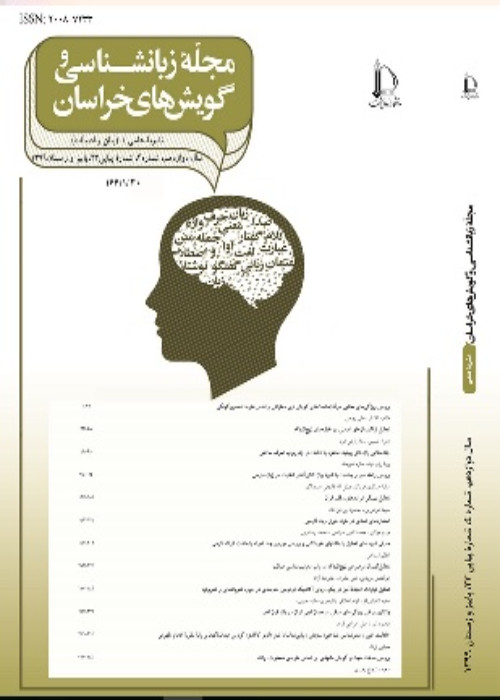The Emic Concept of Face in the Iranian Culture: An Ethnographic Study of Aberu
Recent research on im/politeness in interpersonal pragmatics has witnessed a move away from Brown and Levinsons (1987) much criticized face-saving theory (e.g., Eelen, 2001; Watts, 2003) towards more relational and interactional models that approach face and politeness as distinct concepts (Arundale, 1999, 2006, 2009, 2010; Terkourafi, 2007; ODriscoll, 2007). One consequence of this is the call to investigate the emic concept of face, as it is understood by ordinary people, before any theoretical notion of face can be designated (Arundale, 1999, 2006, 2009, 2010, 2013; Bargiela-Chiappini, 2003; Haugh, 2009, 2013b; Haugh & Bargiela-Chiappini, 2010). This research is a response to this call and tries to analyze emic understandings of the concept of āberu (lit. water-of-face) as the closest equivalent of face in the Iranian culture.
Literature Review : Despite numerous researches on im/politeness in Persian, very few people have directly addressed the concept of face in the Iranian culture. Koutlaki (2002, 2009) argues that ehterām and shakhsiat are two aspects of face in the Iranian culture. Sharifian (2007) and Izadi (2017) offer āberu as the Persian equivalent of face in this culture. However, none of them does an ethnographic study of āberu idioms and collocations.
An ethnographic approach is adopted. Ethnography is a method used to describe everyday human behavior, relying heavily on participant observation in natural settings (Leeds-Hurwitz, 2005). To gather the data, ethnographic field notes were taken of the actual uses of āberu and its idiomatic expressions and collocations in everyday conversations, TV serials, websites and weblogs, paying special attention to all possibly relevant contextual clues. The instances were then semantically analyzed in their contexts of use and a classification of the results was made.
An analysis of āberu idiomatic expressions and collocations shows that the domain of interpersonal relations is understood in terms of the domain of economic activity and the conceptual metaphor (Lakoff & Johnson, 1980) of ĀBERU IS A COMMODITY can be applied to it. The exact nature of this commodity is water, which has always been a rare and hard-to-find resource in the dry and arid climate of Iran. Āberu is the most valuable commodity a person, or group, can possess that can be spilled, bought, sold, pawned, exchanged with money, or even auctioned. The ĀBERU IS A COMMODITY metaphor gives the impression that āberu is possessed by the individual (or group), but the data shows that this āberu exists only in the presence, or perception of the presence, of an other and within an interaction. Therefore, it is not a possession of the individual but, as argued by Arundale (2006, 2009, 2013), is a property of the interaction (cf. Goffman, 1967).
The results also show four main uses of the word āberu in the Iranian culture. First, a persons āberu is connected to the āberu (i.e., good name or reputation) of the group(s), one is associated with at the moment of interaction (Sharifian, 2007; Izadi, 2015, 2017). The group can be as small as the nuclear family or as big as a guild, the whole nation or even all humanity. The most important group is the family, which is then used as a metaphor to invoke protection of the āberu of larger social units such as a company, an organization or even the government.
Second, āberu is linked to peoples sense of competence (cf. Lim & Bowers, 1991), including possessions (i.e., competence in earning a decent living). Any perception of incompetence in the eyes of mardom, the people or significant others may lead to the feeling of āberurizi (lit. Spillage of water-of-face) or face loss.
Third, āberu is linked to the distinction, in Iranian life, between the two domains of zāher/birun (outside) and bāten/andarun (inside) referred to by Beeman (1986). If something that belongs to the realm of inside is revealed in the domain of outside, one may feel a loss of āberu. Things that must not be revealed in the outside cover a large list, including secrets, antisocial behavior or thoughts, any infringement of moral values and norms, misconduct, etc.
Finally, a persons āberu is linked to their perceived shan or social status, which is defined according to age, education, rank in an organization or institutional power, occupation and gender.
Loss of āberu may lead to the feeling of sharm, i.e., shame, which then places the Iranian culture closer to the shame end of the shame/guilt (Benedict, 1946; Ho, 1976) continuum.
Āberu in the Iranian culture covers a larger extent of meanings than adab (politeness), which is considered as formal behavior appropriate to the context. Although āberu is part of the moral order (Garfinkel, 1967) against which im/politeness judgments are based (Haugh, 2013a; Kádár & Haugh, 2013), it is not accurate to equate politeness with face-saving strategies.
In the Iranian culture, my āberu in my eyes is the image I think others have of me and my āberu in others eyes is the image they have of me based on my social status and my verbal and nonverbal behavior. The results also indicate that while most of the descriptions of face in Goffman (1967) apply to āberu, group face, especially a familys face, may impose a second layer of constraints on individual conduct. It is argued that āberu in Persian is both relational and interactional as claimed in Face Constituting Theory (Arundale, 1999, 2006, 2009, 2013). A persons perceived social status influences the way people initially treat him in an interaction but this status has to be maintained and renegotiated within current interaction.
face , aberu , ru , status , Iranian Culture , Ethnography
- حق عضویت دریافتی صرف حمایت از نشریات عضو و نگهداری، تکمیل و توسعه مگیران میشود.
- پرداخت حق اشتراک و دانلود مقالات اجازه بازنشر آن در سایر رسانههای چاپی و دیجیتال را به کاربر نمیدهد.




